3- Syntax
1/25
There's no tags or description
Looks like no tags are added yet.
Name | Mastery | Learn | Test | Matching | Spaced |
|---|
No study sessions yet.
26 Terms
Gramma
A speaker's knowledge of their language
− phonological, morphological, syntactic and semantic information
− A set of rules to create well-formed sentences and the study of that set of rules
− A book which describes the rules of a language
Synatctic constituent
A constituent is "a string of words which syntactically behaves as a unit" (Aarts 2001:289)
- words that "belong together"
− constituents behave as structural units
= such syntactic constituents are called phrases
phrases
syntactic units/constituents
− consist of one or more words
− phrase status can be tested
− are part of the syntactic hierarchy
exp. the students
Types of Phrases
Noun phrase
Verb Phrase
Adjective phrase
Adverb phrase
Prepositional phrase
Determiner phrase
tests for constituents: (5)
pronominalization test
movement test
coordination test
capping test
sentence- fagment test
→ test is positive= probaby a constituent, all test negative= probably not
PRONOMINALIZATION (SUBSTITUTION) TEST
Whole constituents can be replaced by one word (usually a pronoun, but sometimes by other forms).
Movement test
Constituents can be moved into other positions within the sentence
coordination test
Whole constituents can be co-ordinated by and, or, but.
capping
Attaching a tag question that leaves a gap into which whole constituents can be inserted.
sentence-fragment test
Whole constituents can serve as an answer to a question
Types of phrases (5)
− noun phrases (NP)
− verb phrases (VP)
− prepositional phrases (PP)
− adjective phrases (AP)
− adverb phrases (AdvP
→phrases labled according to head of the phrase
head of a phrase
The semantics (meaning) of the phrase
− The phrase obtains/inherits syntactic and semantic properties of the head
word class determinded by :
• semantic criteria (nouns: things, persons; verbs: actions,)
• morphological criteria(derivational & inflectional affixes)
• syntactic criteria (position of the words in a sentence)
form vs function
form: word class, phrases : nouns, verbs, adjectives, adverbs, determiners, cojunctions, prepositions, pronouns, auxillary verbs
function: subject, verb, object, adjunct, complement
direct vs indirect object
indirect; recipient, beneficiary, goal (always 1st)
direct: undergoes a process (always 2nd)
ADVERBIALS / ADJUNCTS
provide (additional) information about circumstances ofthe action (e.g., place, time, manner)
− can occur in several positions in the clause
− are always optional
Adverb vs adjunct

SUBJECT
semantic criteria:
− entity that performs action denoted by verb
− tells us what the sentence is about
agreement:
− agrees with verb regarding number and person
- can be replaced by pronoun in subject case
OBJECT
usually follows the verb (SVO)
− usually obligatory
- becomes subject in passive sentence
- can be replaced by a pronoun in object case
COMPLEMENTS
− some verbs occur with constituents that do not fit the category object− (e.g. seem, become, appear)
− these verbs have a predicative complement instead
− predicative complements cannot be passivized
Word
= lexemes and their word forms
Clause
Syntactic unit, VP has head, makes prediction about world
Phrase
Makes up clauses
Group of words, constituent, named after head
Finite clause/ non finite clause
Containinv finite/ non-finite verb
Sentence
Largest unit, one or more clauses, communicative function
Sentence Types
Declarative (information)
Interrogative (?)
Imperative (order)
Exclamative (exclaim emotion)